How to avoid being scammed through the "A file was shared with you" phishing email
Phishing/ScamAlso Known As: A File Was Shared With You spam
Get free scan and check if your device is infected.
Remove it nowTo use full-featured product, you have to purchase a license for Combo Cleaner. Seven days free trial available. Combo Cleaner is owned and operated by RCS LT, the parent company of PCRisk.com.
What is "A file was shared with you"?
This is one of many phishing emails and is sent by cyber criminals who attempt to steal sensitive information from unsuspecting users. Note that cyber criminals behind phishing emails disguise them as messages from legitimate companies or individuals. In this case, recipients are notified that files regarding bonuses were shared with them.
They are encouraged to review the files by logging into their Microsoft accounts through an 'official' Microsoft sign-in website. The purpose of this scam is to trick recipients into granting permission to a rogue application, which then allows cyber criminals to steal various data from recipients' Microsoft accounts. Neither this, nor other similar emails, can be trusted.
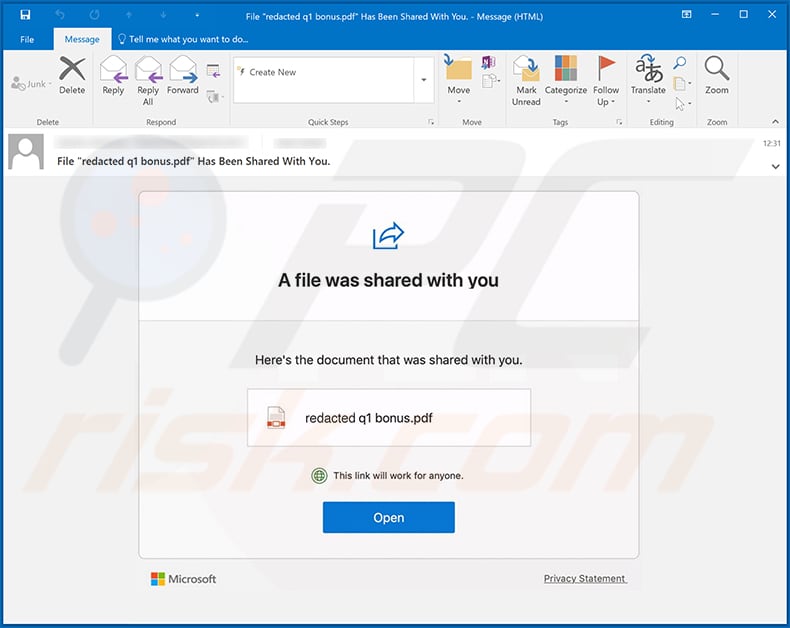
More about the "A file was shared with you" scam email
Cyber criminals behind this phishing email ask recipients to download a file, which is disguised as document regarding a bonus payment. Recipients supposedly download it through the provided website link, which apparently leads to an official Microsoft sign-in website.
The problem with the opened URL is its parameters: "response_time", "redirect uri" and "scope". The first parameter indicates which type of access is requested. In this particular case, an ID token and an authorization code are requested. The rogue application exchanges them into an access token which it uses for data access.
The second parameter specifies the location to which tokens and authorization codes are sent. In this case, to a domain mimicking the legitimate Office 365 entity, which is located in Bulgaria. The third parameter contains permissions that the user gives to the aforementioned rogue application.
Essentially, the main purpose of this phishing attack is to deceive recipients into entering their Microsoft account credentials so that they authenticate through OAuth2 and OIDC protocols.
After authentication, these protocols authorize access for the rogue application, which can then be used by cyber criminals to access Microsoft products and services such as Office, Skype, Outlook, OneDrive, and so on (i.e., to access hosted files, photos, contacts, and other content).
Cyber criminals can use the accessed information to make fraudulent purchases, spread phishing emails (including this one), scam emails or even malware, steal identities, etc. These actions depend on the documents and other data, which the rogue application are able to access on users' Microsoft products or services.
Therefore, this situation can be avoided simply by ignoring these phishing emails and not approving malicious access to data.
| Name | A file was shared with you Email Scam. |
| Threat Type | Phishing, Email Scam, Social Engineering, Fraud. |
| Disguise | This email is disguised as a message regarding a Q1 bonus. |
| Symptoms | Unauthorized online purchases, changed online account passwords, identity theft, illegal access of the computer. |
| Distribution methods | Deceptive emails, rogue online pop-up ads, search engine poisoning techniques, misspelled domains. |
| Damage | Loss of sensitive private information, monetary loss, identity theft. |
| Malware Removal (Windows) |
To eliminate possible malware infections, scan your computer with legitimate antivirus software. Our security researchers recommend using Combo Cleaner. Download Combo CleanerTo use full-featured product, you have to purchase a license for Combo Cleaner. 7 days free trial available. Combo Cleaner is owned and operated by RCS LT, the parent company of PCRisk.com. |
Similar scams
Other examples of email scams are "Your Google Ads Account Has Been Suspended", "ShareFile Attachment" and "Attn Lucky Winner". In most cases, cyber criminals behind them attempt to deceive recipients into providing sensitive information (such as login credentials and credit card details) or transferring money to them.
The emails are often used to trick recipients into installing malware (e.g., ransomware, Trojans) as well. Never provide sensitive, personal information through emails or unknown websites or open files/links within them.
How do spam campaigns infect computers?
Malware is installed through emails when users open malicious attachments, or files that were downloaded through website links within the messages. Some examples of files that cyber criminals often attach to their emails are malicious Microsoft Office documents, PDF documents, executable files (.exe), archive files (ZIP, RAR), and JavaScript files.
Note that malicious MS Office documents infect computers only if users give them permission to enable editing/content (macros commands). Note that malicious documents opened with versions older than Microsoft Office 2010 will install malware without asking any permissions (since those versions do not include Protected View mode).
How to avoid installation of malware
Do not trust or open emails that are irrelevant, received from suspicious, unknown addresses, or contain attachments and/or website links. Software should be downloaded only from official web pages and via direct download links.
Peer-to-Peer networks, third party downloaders, unofficial pages, etc., should not be trusted and could be used to proliferate malicious files and programs. Third party installers are also used to distribute malware. Installed software must be updated and activated (if necessary) through implemented functions and tools designed by official developers.
Note that it is illegal to activate licensed software with third party tools, and they often infect computers with malware. Finally, it is important to regularly scan the computer for threats with a reputable antivirus or anti-spyware suite and keep it up to date.
If you have already opened malicious attachments, we recommend running a scan with Combo Cleaner Antivirus for Windows to automatically eliminate infiltrated malware.
Official Microsoft sign-in page used to provide access for the rogue application:
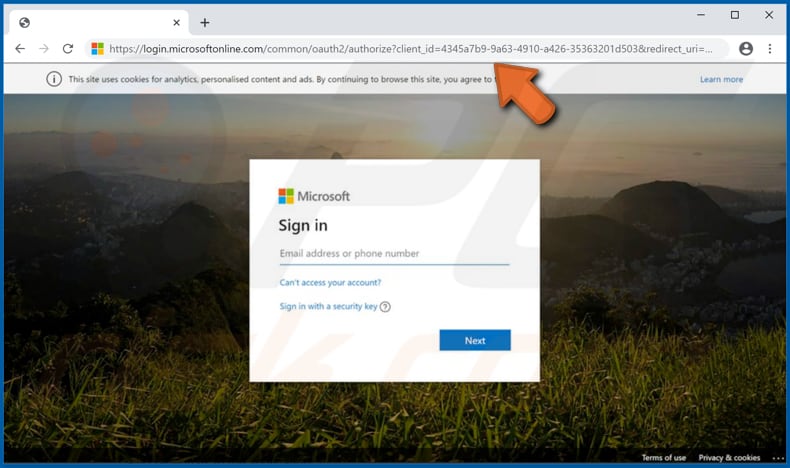
Another example of shared documents-themed spam email used to promote a phishing site:
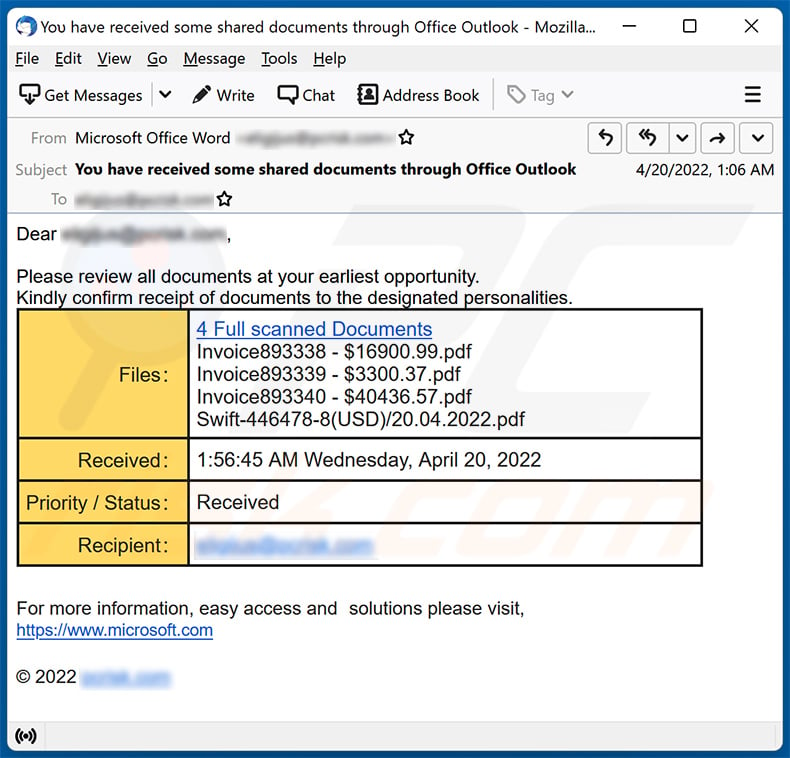
Text presented within:
Subject: You have received some shared documents through Office Outlook
Dear ********,
Please review all documents at your earliest opportunity.
Kindly confirm receipt of documents to the designated personalities.
Files:4 Full scanned Documents
Invoice893338 - $16900.99.pdf
Invoice893339 - $3300.37.pdf
Invoice893340 - $40436.57.pdf
Swift-446478-8(USD)/20.04.2022.pdf
Received: 1:56:45 AM Wednesday, April 20, 2022
Priority / Status: Received
Recipient: ********For more information, easy access and solutions please visit,
hxxps://www.microsoft.com© 2022 ********
Another example of file sharing-themed spam email promoting a phishing site:
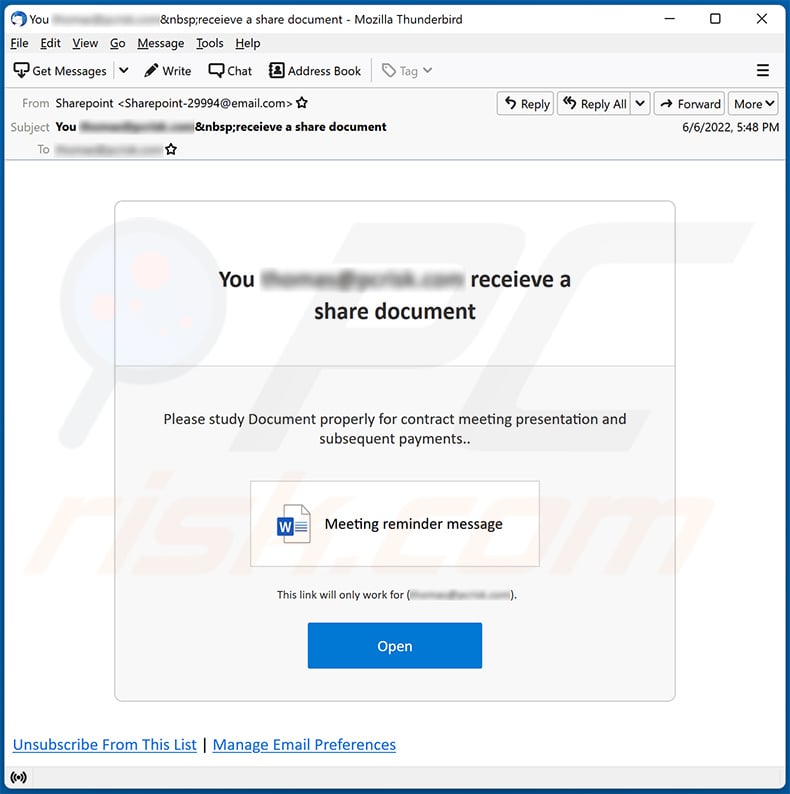
Text presented within:
Subject: You - receieve a share document
You - receieve a share document
Please study Document properly for contract meeting presentation and subsequent payments..
Meeting reminder message
This link will only work for (-).
Open
Unsubscribe From This List | Manage Email Preferences
Screenshot of the promoted phishing site:
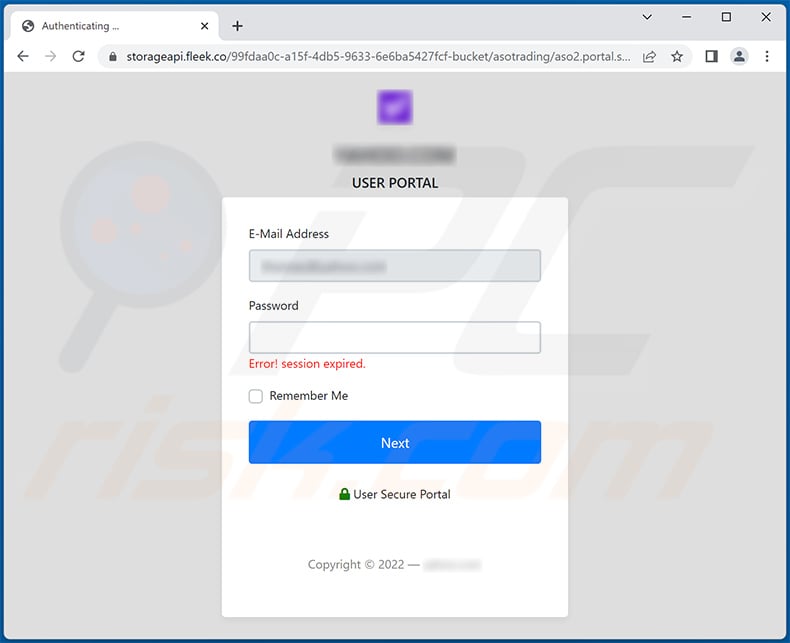
Yet another example of file sharing-themed spam email promoting a phishing site:
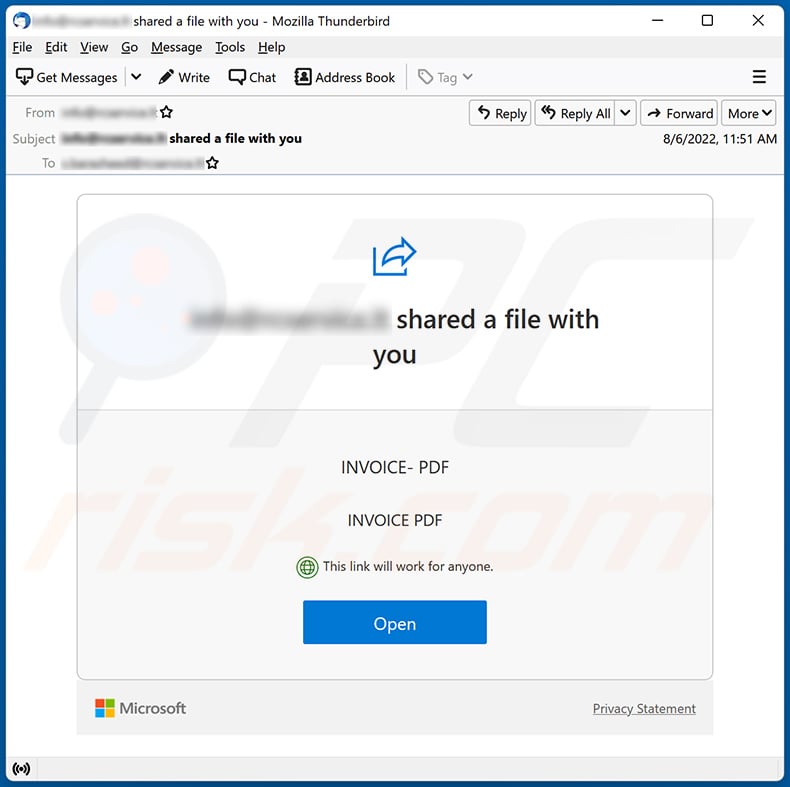
Text presented within:
Subject: ******** shared a file with you
******** shared a file with you
INVOICE- PDF
INVOICE PDF
permission globe icon This link will work for anyone.
Open
Microsoft Privacy Statement
Screenshot of the promoted phishing site:
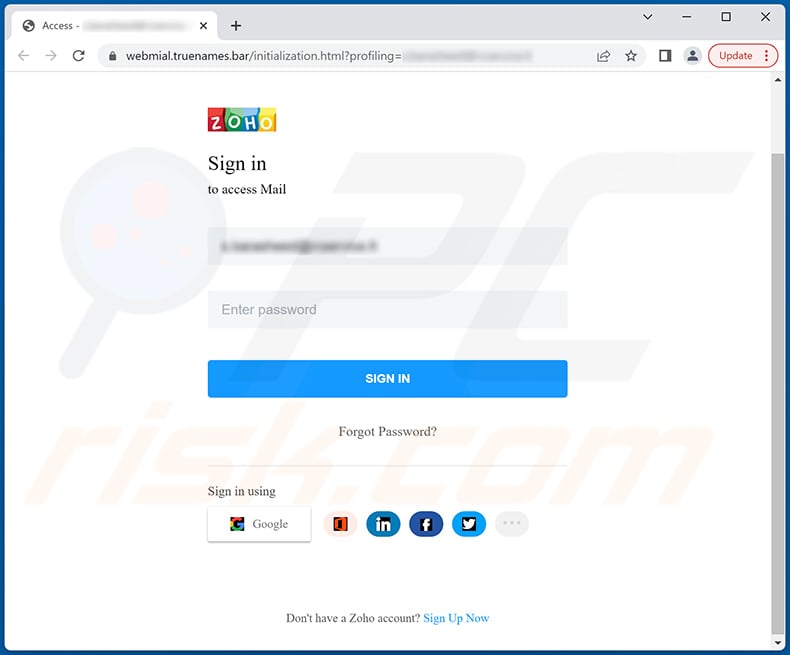
Another example of file sharing-themed spam email spreading an HTML document used for phishing purposes:
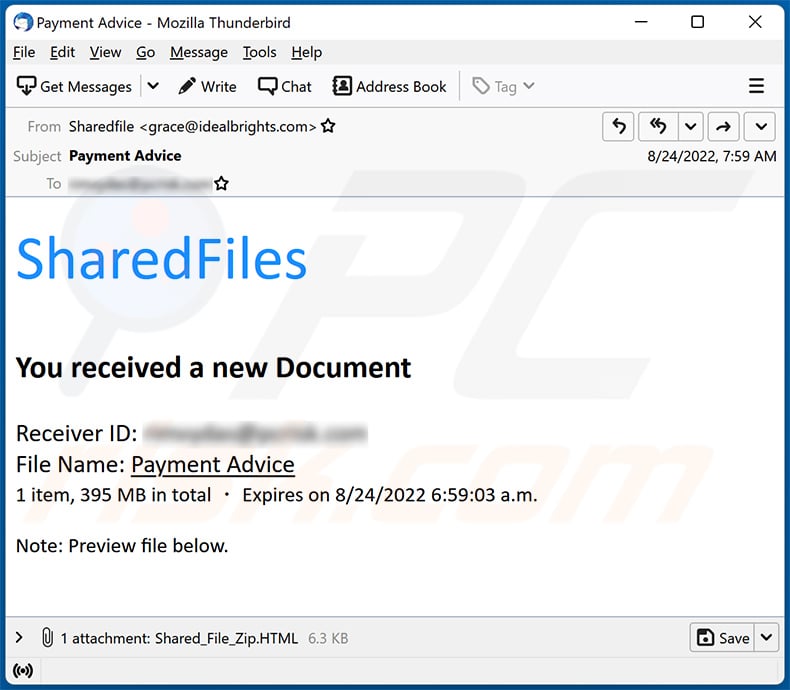
Text presented within:
Subject: Payment Advice
SharedFiles
You received a new Document
Receiver ID: -
File Name: Payment Advice
1 item, 395 MB in total ・ Expires on 8/24/2022 6:59:03 a.m.Note: Preview file below.
Screenshot of the attached HTML document:
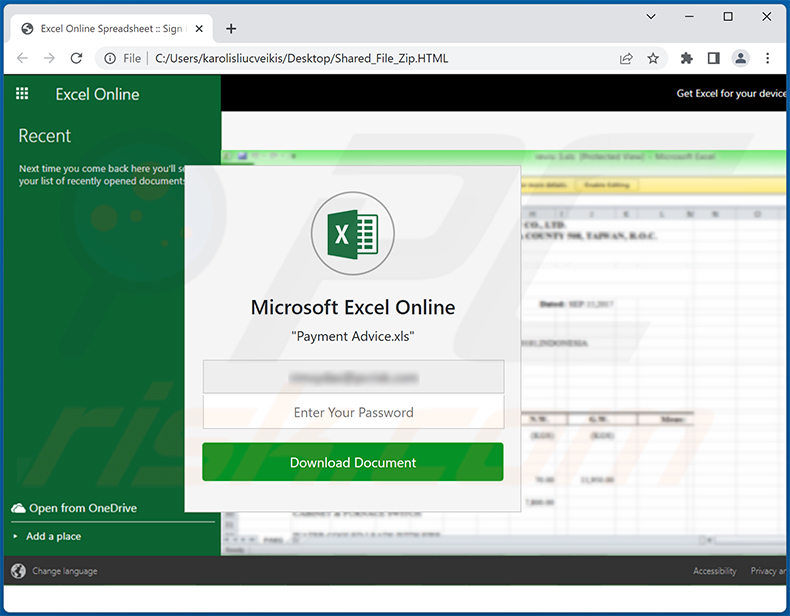
Another example of an email from "A File Was Shared With You" spam campaign:
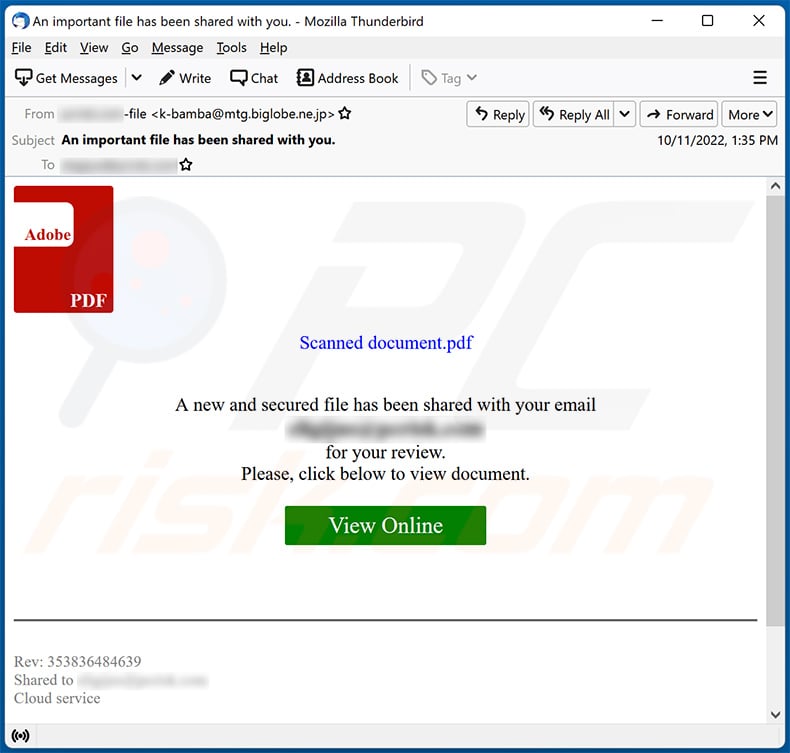
Text presented within:
Subject: An important file has been shared with you.
Adobe PDF
Scanned document.pdf
A new and secured file has been shared with your email
-
for your review.
Please, click below to view document.View Online
Rev: 353836484639
Shared to -
Cloud service
Screenshot of the promoted phishing site:
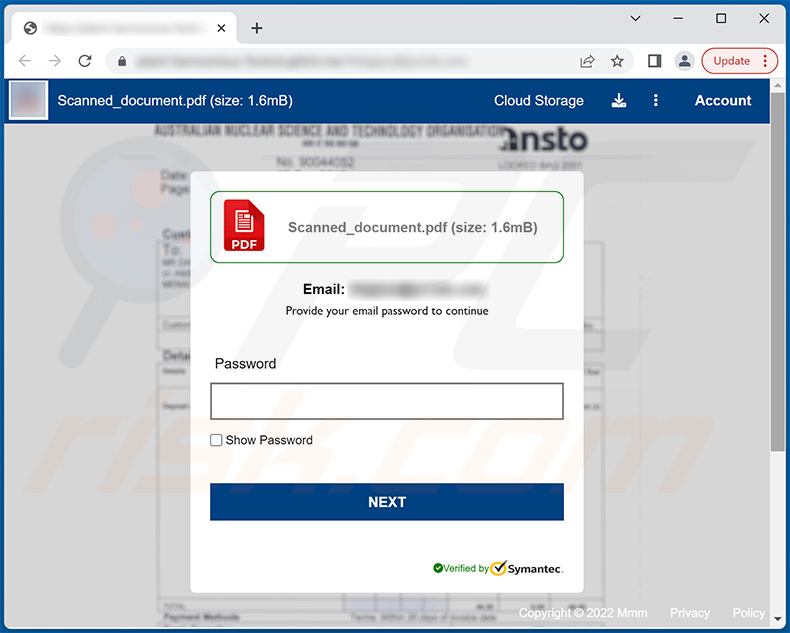
Yet another example of an email from "A File Was Shared With You" spam campaign:
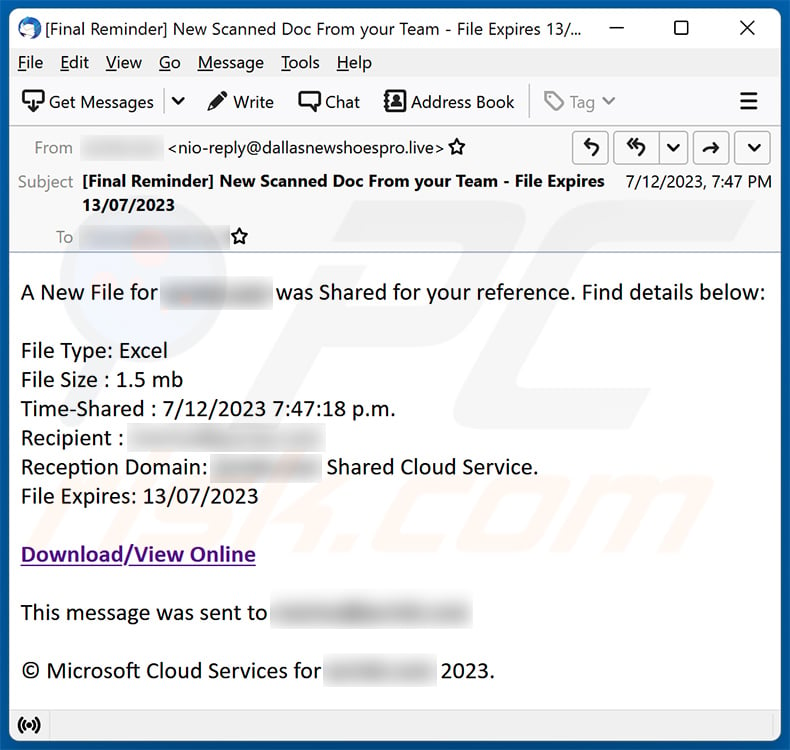
Text presented within:
Subject: [Final Reminder] New Scanned Doc From your Team - File Expires 13/07/2023
A New File for ******** was Shared for your reference. Find details below:
File Type: Excel
File Size : 1.5 mb
Time-Shared : 7/12/2023 7:47:18 p.m.
Recipient : ********
Reception Domain: ******** Shared Cloud Service.
File Expires: 13/07/2023Download/View Online
This message was sent to ********
© Μicrosoft Cloud Services for ******** 2023.
Screenshot of the promoted phishing site:
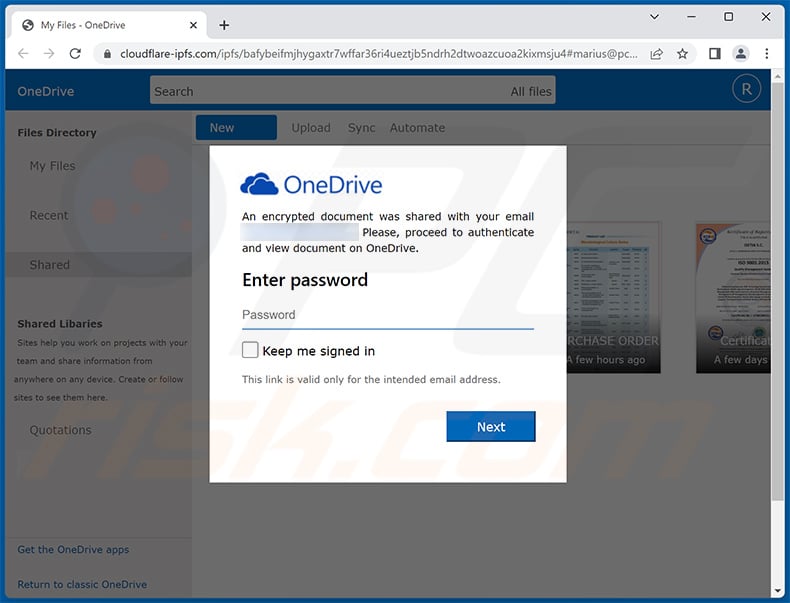
Instant automatic malware removal:
Manual threat removal might be a lengthy and complicated process that requires advanced IT skills. Combo Cleaner is a professional automatic malware removal tool that is recommended to get rid of malware. Download it by clicking the button below:
DOWNLOAD Combo CleanerBy downloading any software listed on this website you agree to our Privacy Policy and Terms of Use. To use full-featured product, you have to purchase a license for Combo Cleaner. 7 days free trial available. Combo Cleaner is owned and operated by RCS LT, the parent company of PCRisk.com.
Quick menu:
- What is A File Was Shared With You spam?
- Types of malicious emails.
- How to spot a malicious email?
- What to do if you fell for an email scam?
Types of malicious emails:
![]() Phishing Emails
Phishing Emails
Most commonly, cybercriminals use deceptive emails to trick Internet users into giving away their sensitive private information, for example, login information for various online services, email accounts, or online banking information.
Such attacks are called phishing. In a phishing attack, cybercriminals usually send an email message with some popular service logo (for example, Microsoft, DHL, Amazon, Netflix), create urgency (wrong shipping address, expired password, etc.), and place a link which they hope their potential victims will click on.
After clicking the link presented in such email message, victims are redirected to a fake website that looks identical or extremely similar to the original one. Victims are then asked to enter their password, credit card details, or some other information that gets stolen by cybercriminals.
![]() Emails with Malicious Attachments
Emails with Malicious Attachments
Another popular attack vector is email spam with malicious attachments that infect users' computers with malware. Malicious attachments usually carry trojans that are capable of stealing passwords, banking information, and other sensitive information.
In such attacks, cybercriminals' main goal is to trick their potential victims into opening an infected email attachment. To achieve this goal, email messages usually talk about recently received invoices, faxes, or voice messages.
If a potential victim falls for the lure and opens the attachment, their computers get infected, and cybercriminals can collect a lot of sensitive information.
While it's a more complicated method to steal personal information (spam filters and antivirus programs usually detect such attempts), if successful, cybercriminals can get a much wider array of data and can collect information for a long period of time.
![]() Sextortion Emails
Sextortion Emails
This is a type of phishing. In this case, users receive an email claiming that a cybercriminal could access the webcam of the potential victim and has a video recording of one's masturbation.
To get rid of the video, victims are asked to pay a ransom (usually using Bitcoin or another cryptocurrency). Nevertheless, all of these claims are false - users who receive such emails should ignore and delete them.
How to spot a malicious email?
While cyber criminals try to make their lure emails look trustworthy, here are some things that you should look for when trying to spot a phishing email:
- Check the sender's ("from") email address: Hover your mouse over the "from" address and check if it's legitimate. For example, if you received an email from Microsoft, be sure to check if the email address is @microsoft.com and not something suspicious like @m1crosoft.com, @microsfot.com, @account-security-noreply.com, etc.
- Check for generic greetings: If the greeting in the email is "Dear user", "Dear @youremail.com", "Dear valued customer", this should raise suspiciousness. Most commonly, companies call you by your name. Lack of this information could signal a phishing attempt.
- Check the links in the email: Hover your mouse over the link presented in the email, if the link that appears seems suspicious, don't click it. For example, if you received an email from Microsoft and the link in the email shows that it will go to firebasestorage.googleapis.com/v0... you shouldn't trust it. It's best not to click any links in the emails but to visit the company website that sent you the email in the first place.
- Don't blindly trust email attachments: Most commonly, legitimate companies will ask you to log in to their website and to view any documents there; if you received an email with an attachment, it's a good idea to scan it with an antivirus application. Infected email attachments are a common attack vector used by cybercriminals.
To minimise the risk of opening phishing and malicious emails we recommend using Combo Cleaner Antivirus for Windows.
Example of a spam email:

What to do if you fell for an email scam?
- If you clicked on a link in a phishing email and entered your password - be sure to change your password as soon as possible. Usually, cybercriminals collect stolen credentials and then sell them to other groups that use them for malicious purposes. If you change your password in a timely manner, there's a chance that criminals won't have enough time to do any damage.
- If you entered your credit card information - contact your bank as soon as possible and explain the situation. There's a good chance that you will need to cancel your compromised credit card and get a new one.
- If you see any signs of identity theft - you should immediately contact the Federal Trade Commission. This institution will collect information about your situation and create a personal recovery plan.
- If you opened a malicious attachment - your computer is probably infected, you should scan it with a reputable antivirus application. For this purpose, we recommend using Combo Cleaner Antivirus for Windows.
- Help other Internet users - report phishing emails to Anti-Phishing Working Group, FBI’s Internet Crime Complaint Center, National Fraud Information Center and U.S. Department of Justice.
Frequently Asked Questions (FAQ)
Why did I receive this email?
Scammers send identical letters to numerous recipients, hoping to trick someone into falling for their scheme. These spam emails lack any personalization.
I have provided my personal information when tricked by this email, what should I do?
If you have shared any of your account credentials (e.g., usernames and passwords), you should change all of your passwords immediately. If you have disclosed any other personal information, such as credit card details or identification card information, it's recommended that you get in touch with the relevant authorities as soon as possible.
I have downloaded and opened a malicious file attached to an email, is my computer infected?
If that file happens to be an executable, then the likelihood of an infection is high. However, if it was a document like .pdf or .doc, there is a chance that you were able to evade the malware, as merely opening the document may not necessarily lead to system infiltration in certain cases.
I have read the email but did not open the attachment, is my computer infected?
Merely opening an email is not harmful in any way. The real danger lies in clicking on links within the emails or opening attachments, as these actions can lead to system infections.
Will Combo Cleaner remove malware infections that were present in email attachment?
Combo Cleaner can identify and remove nearly all recognized types of malware infections. However, it is important to note that sophisticated malware can often conceal itself deep within the system. That is why a comprehensive system scan is essential to ensure complete removal.
Share:

Tomas Meskauskas
Expert security researcher, professional malware analyst
I am passionate about computer security and technology. I have an experience of over 10 years working in various companies related to computer technical issue solving and Internet security. I have been working as an author and editor for pcrisk.com since 2010. Follow me on Twitter and LinkedIn to stay informed about the latest online security threats.
PCrisk security portal is brought by a company RCS LT.
Joined forces of security researchers help educate computer users about the latest online security threats. More information about the company RCS LT.
Our malware removal guides are free. However, if you want to support us you can send us a donation.
DonatePCrisk security portal is brought by a company RCS LT.
Joined forces of security researchers help educate computer users about the latest online security threats. More information about the company RCS LT.
Our malware removal guides are free. However, if you want to support us you can send us a donation.
Donate
▼ Show Discussion